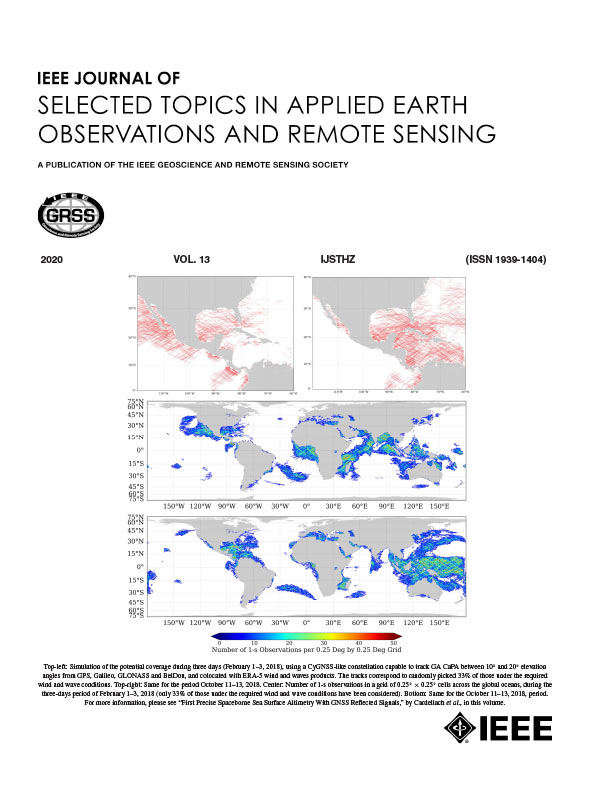Comparison of Two Spatiotemporal Reconstruction Methods for Spaceborne Sea Surface Temperature Data at Multiple Temporal Resolutions
IF 4.7
2区 地球科学
Q1 ENGINEERING, ELECTRICAL & ELECTRONIC
IEEE Journal of Selected Topics in Applied Earth Observations and Remote Sensing
Pub Date : 2024-09-09
DOI:10.1109/JSTARS.2024.3453508
引用次数: 0
Abstract
The satellite remote sensing sea surface temperature (SST) plays a crucial role in global climate change and ocean–atmosphere interactions. With a notably severe issue of missing data due to clouds and rainfall, data reconstruction methods have been developed to effectively enhance the spatiotemporal completeness of satellite-derived SST data products in recent years. However, few studies have focused on performance comparisons between these different data reconstruction methods, which limits further improvement and application of reconstructed data products. In this study, two representative methods, the data interpolating empirical orthogonal functions (DINEOF) and a spatiotemporal geostatistical method of Bayesian maximum entropy (BME), were used to reconstruct satellite SST data in four regions, and their reconstruction performance under various temporal resolutions (hourly, daily, and monthly) and missing data rates were evaluated and compared. Our results demonstrate that BME consistently outperforms DINEOF. As the missing data rate increases from 10% to 90%, especially when it exceeds 70%, DINEOF reconstruction results exhibit significant increasing noises and reconstruction errors, while BME demonstrates stable precise reconstruction results. Compared with DINEOF method, the results of BME method are less influenced by missing data rates, spatiotemporal resolutions, temporal length, and regions of input data series by different remote sensing sensors, rendering it more applicable and robust in reconstructing multisensor SST data with different temporal resolutions. The BME method holds promising implications in reconstructing high-quality gap-filled data using noisy and high-missing-rate multisensor data in regional areas with high dynamics.多时间分辨率空间海表温度数据的两种时空重建方法比较
卫星遥感海面温度(SST)在全球气候变化和海洋-大气相互作用中发挥着至关重要的作用。由于云层和降雨导致的数据缺失问题尤为严重,近年来人们开发了数据重建方法,以有效提高卫星海表温度数据产品的时空完整性。然而,很少有研究关注这些不同数据重建方法之间的性能比较,这限制了重建数据产品的进一步改进和应用。本研究采用数据插值经验正交函数(DINEOF)和贝叶斯最大熵(BME)时空地理统计方法这两种具有代表性的方法来重建四个区域的卫星 SST 数据,并评估和比较了它们在不同时间分辨率(小时、日和月)和数据缺失率下的重建性能。结果表明,BME 始终优于 DINEOF。随着缺失数据率从 10%增加到 90%,特别是当缺失数据率超过 70%时,DINEOF 重建结果的噪声和重建误差显著增加,而 BME 则表现出稳定精确的重建结果。与 DINEOF 方法相比,BME 方法的结果受不同遥感传感器输入数据序列的缺失率、时空分辨率、时间长度和区域的影响较小,因此在重建不同时间分辨率的多传感器 SST 数据时更加适用和稳健。BME 方法在利用高动态区域的高噪声和高缺失率多传感器数据重建高质量的间隙填充数据方面具有广阔的前景。
本文章由计算机程序翻译,如有差异,请以英文原文为准。
求助全文
约1分钟内获得全文
求助全文
来源期刊
CiteScore
9.30
自引率
10.90%
发文量
563
审稿时长
4.7 months
期刊介绍:
The IEEE Journal of Selected Topics in Applied Earth Observations and Remote Sensing addresses the growing field of applications in Earth observations and remote sensing, and also provides a venue for the rapidly expanding special issues that are being sponsored by the IEEE Geosciences and Remote Sensing Society. The journal draws upon the experience of the highly successful “IEEE Transactions on Geoscience and Remote Sensing” and provide a complementary medium for the wide range of topics in applied earth observations. The ‘Applications’ areas encompasses the societal benefit areas of the Global Earth Observations Systems of Systems (GEOSS) program. Through deliberations over two years, ministers from 50 countries agreed to identify nine areas where Earth observation could positively impact the quality of life and health of their respective countries. Some of these are areas not traditionally addressed in the IEEE context. These include biodiversity, health and climate. Yet it is the skill sets of IEEE members, in areas such as observations, communications, computers, signal processing, standards and ocean engineering, that form the technical underpinnings of GEOSS. Thus, the Journal attracts a broad range of interests that serves both present members in new ways and expands the IEEE visibility into new areas.

 求助内容:
求助内容: 应助结果提醒方式:
应助结果提醒方式:


